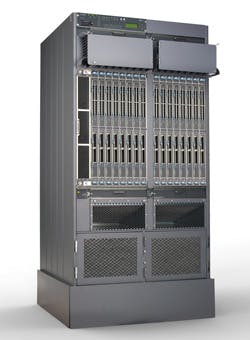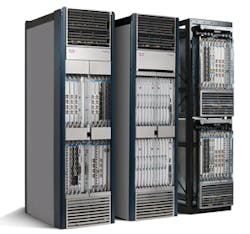New adventures in label switching
By Stephen Hardy
When it comes to conflating layers in the transport core, carriers must decide how to connect the IP layer and the optical layer. Viewing this conundrum from a hardware perspective, this decision initially meant getting the IP core router and the optical core transport system to play nicely together.
Juniper Networks upset this hardware apple cart in March 2011 when it launched the PTX Series Packet Transport Switch, a platform focused on the MPLS label-switch function IP core routers perform among their other tasks (and that large-scale packet-optical transport systems are being designed to perform as an alternative path toward layer convergence – see “Architecture options for converged packet-optical networks” on page 10 of this issue). The resultant standalone label-switch router (LSR) promised high capacity and a more efficient and less expensive way to perform packet routing via MPLS than your average core router.
But who would want to spend money on a platform that “just” performed label switching? Well, as announced this past June, Verizon for one. The carrier’s deployment of the 8-Tbps version of the PTX family (the PTX5000, half the capacity of the larger PTX9000) firmly establishes the market viability of the platform as an alternative to core routers and once again puts Juniper on a collision course with its chief rival, Cisco.
A switch in time
A label-switch router routes packets based on MPLS labels along a Layer 2 label-switch path rather than resorting to IP addresses (a Layer 3 function). The IP control plane is still in force, which is one reason why some refer to MPLS label switching as a “Layer 2.5” function.
One goal of IP/optical convergence is to minimize the use of IP router ports, primarily for cost reasons but also to improve latency and other performance metrics. “I would tend to say, from an architectural standpoint, that if all you had were packets, that you’d want to send them all on Layer 2,” offers Rick Talbot, senior analyst, optical infrastructure, at market research and analysis firm Current Analysis. And that’s why Juniper came up with PTX – the belief that, in some parts of the core network, all you’ll want to do is forward packets, rather than invoke Layer 3 functions.
“In the core of the network, there’s typically less services associated with it. It’s really all about moving information. So with an LSR, you actually approach the design and functionality of a circuit network, but you still have the advantage of statistical multiplexing that you have with a packet network,” explains Luc Ceuppens, vice president of product marketing in the High-End Systems Business Unit of Juniper Networks.
Despite not being an IP router, an LSR still fits neatly into an IP/optical convergence strategy, Ceuppens maintains. “It’s literally like taking a core router, maintaining the control plane, but taking the IP capabilities out of the forwarding plane. That is a synopsis of what the PTX does,” Ceuppens explains. ”And that way it optimizes latency, it optimizes power consumption, it optimizes scale, it optimizes density, and it optimizes cost.”
But it’s still a brand new piece of hardware that carriers would have to add to their networks. Ceuppens insists that the PTX Series (which, as of the time this issue went to press, was the only available standalone LSR for large-scale IP-based core networks) still saves carriers money by stripping out the cost of IP core-router functions that carriers don’t need everywhere they require label-switch routing.
Talbot believes the argument has merit. He points out that adding LSR ports to a core router (usually via LSR-specific line cards and software packages) still requires an investment in the core-router chassis, which tends to be more expensive than an LSR chassis. And any slot an LSR card occupies in a core router is one that can’t be dedicated to IP routing, which can be an issue if IP routing requirements increase.
“At the end of the day, I think the reality is that the LSR is the less expensive way to do it,” Talbot tells Lightwave. “But, of course, it’s always a question of scale. If someone has routers in place, and the network wasn’t going to grow to the point of needing more routers, then you’d be fine using the LSR ports [in the core router].”
Talking optics
Of course, one of the basic tenants of IP/optical convergence is that the IP and optical layers have to interact. How this interaction occurs is a point of contention between the optical and IP camps. The IP camp would prefer that the long-haul optics be integrated into the routers, thus giving the router and the IP layer the lead role. Those who trust in the optical layer believe the routers should carry no more than gray optics, giving the optical transport platforms the final say in managing transmission, protection, and restoration.
Most core-router vendors are a long way down the path of develop-ing integrated 100-Gbps long-haul optics, but Juniper has had to play catchup. The first versions of the PTX Series come with a separate optical transport shelf co-developed with ADVA Optical Networking.
Juniper, however, has worked strenuously to come up with integrated 100G optics and demonstrated a prototype of this arrangement at OFC/NFOEC this past March. PTX Series platforms with integrated optics should be available early in 2013, Ceuppens says. And then, let the debate begin.
“Depending upon what service provider you talk to, they’re still not sold on the integrated optical transponders in the core routers,” Ceuppens allows. “But I believe that as time progresses, that may change.”
Ceuppens believes such a change will be based on price and performance advantages. For example, an LSR might be able to detect impending faults and initiate protection mechanisms more quickly than a packet-optical transport platform. Take the case of a fiber cut, he offers. Right before the cable breaks, it typically stretches. Such stretching will affect packet flow, which an LSR will notice and an optical transport platform won’t. That stretching may only precede the break by a second or two – but that’s enough time to switch a lot of traffic, he points out.
Yet there’s a technical hurdle toward the integrated optics approach that probably will have to be overcome before carries like Verizon lighten the responsibilities of their packet-optical transport platforms: the communication between the router (regardless of the type) and the optical transport system. While such processes are in place, they tend to come in proprietary flavors. This fact gives some carriers an uncomfortable taste in their mouths when the router comes from one vendor and the optical transport system from another.Juniper will attempt to get around this problem by publishing a “virtual transponder interface” that it hopes optical transport vendors will adopt.
Let the battle begin
While more standards likely will be necessary before true IP/optical convergence occurs on a wide scale, the successful introduction of the PTX Series bodes well for the LSR as a viable option for carriers who seek to streamline their core networks. It would appear that, at least initially, there will be room for both standalone LSRs and LSR-enabled core routers in the market – perhaps even in the same network, given that Verizon already uses Cisco’s CRS-3 in its backbone.
“It’s going to take a while to figure out if it’s going to swing or not,” says Talbot of whether the market is likely to favor standalone LSRs over the use of core routers. “Even if it does, both companies [Juniper and Cisco] have enough market power that they can roll out a number of demos and a number of sales to make it very difficult to tell if someone’s got the advantage or not.”
STEPHEN HARDY is editorial director and associate publisher of Lightwave.


